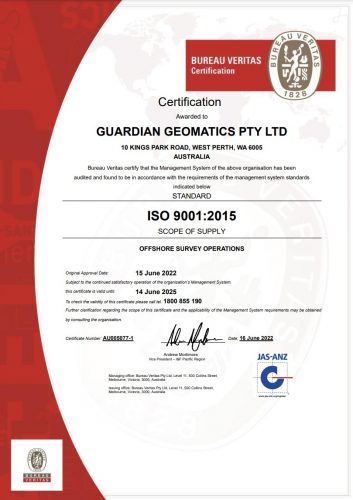HEALTH , SAFETY, ENVIRONMENT AND QUALITY
Guardian implements a hazard and risk identification management strategy with the intent of eliminating identified hazards or managing the residual risk of the identified hazard to As Low As Reasonably Practicable (ALARP), when elimination is assessed as not possible.
Guardian recognises that unidentified hazards or inadequately controlled residual risks, exposes all stakeholders to unacceptable business, environmental and personal risk levels. One, or a combination of these, has the potential to adversely affect our ability to protect employees, clients and business continuity.
- Full time, dedicated HSEQ Manager - David Nicholas.
- ISNet world category A (no. 400-332227).
- LTI free over previous 12 months.
- Document of Compliance (DOC) in line with ISM code released for operational use, June 2018.
- Paperless “Integrated Management System (IMS)" was rolled out across all vessels, 2018.
- ISO 9001:2015, 14001:2015 & ISO 45001:2018 audit completed June 2022 by Bureau Veritas as the certifying body. Click to view full BV certificates below.



Categorised Hazards
Guardian has categorised hazards and residual risks resultant from its activities, which if realised have the potential to cause harm or loss, as detailed below.
| AFFECTED | REALISATION |
| Personnel | Work Related physical injury or illness suffered by a person resultant from The Company’s activities. |
| Environment | Adverse environmental or community impact. |
| Business Continuity | Damage, operational downtime, contract loss, theft. |
| Reputation | Inability to secure or maintain contracts due to negative performance affecting Personnel, Environment or Business. |
Risk Management Methodology
Guardians' Risk Management methodology is based upon the structured frame work as detailed in ISO 31000 - Risk Management, illustrated in the right-hand figure.
Through strict implementation of its risk management process, Guardian shall ensure that identification of hazards, and subsequent risk treatment is implemented to ensure the outcomes of safe, efficient and reliable operations for all stakeholders, both internal and external.
Guardians' Risk Matrix
Quality Management Strategy
Guardian implements a quality management strategy to ensure all our data acquisition and data deliverables meet the specification required by the client or international bodies.
QUALITY MANAGEMENT
Guardian recognises that quality data delivered on time are key to our stakeholders and implement a quality management system in accordance with ISO 9001 that covers the life cycle of the project from kick-off to close out.
The quality management system includes planning, acquisition, processing and reporting and references various quality control procedures and include such items as:
- Pre/post inspection sheets.
- Inspection Test Plans (ITP’s).
- Calibration reports; and,
- A robust quality control methodology.
SERVICE PROVISION OBJECTIVE
Guardian’s service provision objective is to provide Safe, Reliable and Efficient service to our Clients with and minimisation of impact to the environment which Guardian operate. Guardian sets quantified and measurable KPIs for these objectives and consistently reviews performance against KPIs.
Guardian’s continuous improvement process as illustrated below, provides the systematic process to meet expectations.
Periodic performance review, monthly and annually, are conducted to assess our level of achievement towards our strategic mission, as well as opportunities for improvement.




